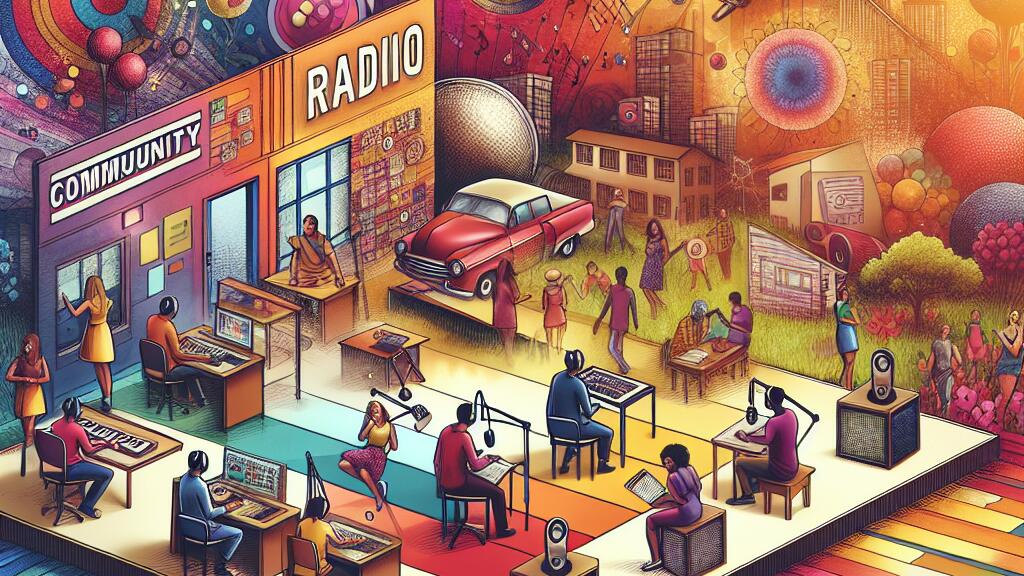What are the essential components of a community radio station
Table Of Contents
Key Takeaways
- Understanding the Essential Components of a Community Radio Station
- Exploring the Vital Role of Audio Gear in a Community Radio Station
- The Significance of Radio Studio Tools in Setting Up Community Radio
- Broadcasting Gear: The Foundation of Community Radio
- Deciphering the Function of FM Transmitter in Community Radio Broadcasting
Understanding the Key Elements of a Community Radio Station
A community radio station is an integral part of local engagement, providing a platform for diverse voices and perspectives. What are the essential components of a community radio station and how do they come together to create a vibrant broadcasting hub? From the radio transmitter to the studio equipment, each element plays a crucial role in delivering relevant content to the community. With a strong emphasis on community-centric programming, these stations act as the passers of information, much like air-traffic-control guiding the flow of communication. The depth of their impact extends beyond just broadcasting; they serve as a catalyst for social change and cultural preservation within their radius. With a focus on quality programming and adherence to community radio guidelines, these stations are more than just operators – they are the heartbeat of community development ethos.
Defining a Community Radio Station: Deeper Dive
Community radio stations are pivotal hubs that amplify the voices of local communities by offering a platform for alternative viewpoints and grassroots engagement. Essential components of a community radio station include a diverse range of volunteer presenters, broadcasting equipment like FM radio transmitters, and studio space where programs are produced. These stations often focus on local issues and interests, catering to a wide spectrum of listeners within their coverage area. By increasing civic participation and promoting a sense of community, community radio broadcasts serve as a vital link between the station and its audience, fostering a union that enhances the social fabric.
The Significance of Communitycentric Broadcasting
Community-centric broadcasting plays a pivotal role in amplifying the voices of underrepresented communities through community radio stations. These stations serve as platforms that uphold the rights of citizens to freely express themselves, share insights, and partake in meaningful dialogues. At the core of community radio stations are the essential components like microphones, microphone processors, mic arms, and audio broadcasting licenses that enable the stations to function effectively. By providing a medium for local artists, educators, and activists to broadcast content relevant to the community, these stations foster a sense of unity and empowerment among residents.
The management structure of community radio stations is designed to ensure that programming aligns with the station’s objectives and the needs of the community it serves. Through collaborations with local organizations and funders, these stations secure the resources necessary to sustain operations and deliver quality programs. By adhering to broadcast regulations and guidelines, community radio stations uphold the spirit of citizen-led media that focuses on promoting arts, education, and cultural diversity. As a result, community-centric broadcasting not only enhances audience reach but also cultivates a sense of pride and ownership among community members towards their station.
- Promotes diversity and inclusivity in media representation
- Enhances community engagement and participation
- Supports local talent and content creation
- Fosters a sense of belonging and empowerment among residents
- Strengthens community ties and relationships
Exploring the Critical Role of Audio Equipment in a Community Radio Station
Understanding the key components of a community radio station is essential in grasping the significance of audio equipment within this setting. From communication to community development aims, audio mixer consoles and microphones play a pivotal role in ensuring transparency and broadcasting community programming efficiently. The collaboration between presenters and interviewees, along with the broadcast of diverse content like news, talk radio, and music librarian selections, caters to a wide audience and fosters a sense of community-mindedness. The use of stereo analog FM transmitters guarantees the broadcast of high-quality content, enriching the airwaves with programs that align with the station’s ethos and resonate with its audience.
Core Audio Equipment for Community Radio: A Closer Look
When it comes to setting up a community radio station, understanding the core audio equipment is crucial for optimal performance. Essential components of a community radio station include a wide range of audio equipment such as UHF slot antennas, band couplers, and quality RDS encoders for broadcasting clear, quality sound. With the right audio equipment, a community radio station can maintain a professional sound quality that attracts listeners and effectively conveys its messages to the audience.
In the context of community radio stations in Nepal and Australia, adhering to the broadcasting act and regulations is vital. Community radio stations, often associated with universities or mass communications programs, must operate within the legal framework set forth by the telecommunications commission or other relevant authorities. To ensure the station’s longevity and service to the community, licensing requirements must be met, and the station must maintain a focus on community service remit. By understanding the significance of core audio equipment and complying with regulations, community radio stations can continue to make a positive impact on society through their broadcasting activities.
Selecting the Right Audio Equipment for Optimal Performance
When it comes to selecting the right audio equipment for optimal performance at a community radio station, several considerations must be taken into account. The primary focus should be on choosing equipment that caters to the specific needs and aims of the station while aligning with the budget and resources available. Equipment such as the VoxBox, CD players, and microphones play a crucial role in ensuring high-quality audio output that resonates with the audience and enhances the overall listening experience.
Moreover, in the context of community radio stations, the selection of audio equipment touches upon various aspects, from fundraising and securing government funding to negotiating business arrangements. It is imperative to strike a balance between quality and cost-effectiveness to ensure that the station can operate efficiently within its financial limits. Additionally, exploring partnerships with foundations, nonprofits, and other community organizations can provide opportunities for securing equipment donations or discounted rates, thereby supporting the station in fulfilling its mission and serving the community effectively.
The Importance of Radio Studio Equipment in Establishing Community Radio
When establishing a community radio station, the importance of radio studio equipment cannot be overstated. The radio studio is where the magic happens, where community radio broadcasters bring their programs to life. Essential components of a community radio station such as microphones, audio consoles, audio processors, and broadcast desks play a crucial role in ensuring high-quality broadcasts that engage and resonate with the community. The right radio studio equipment not only enhances the quality of the programs but also contributes to the overall success and viability of the community radio project. It is vital for community radio broadcasters to select the appropriate radio broadcast equipment that aligns with their goals and community broadcasting strategy. The radio studio serves as the heart of the station, where community voices are amplified, and stories are shared, making it a pivotal platform for promoting community views and concerns.
| Equipment | Description |
|---|---|
| Microphones | Used to capture voices and sounds for broadcasting |
| Audio Consoles | Control centers for adjusting audio levels and mixing different audio sources |
| Audio Processors | Devices that enhance and optimize audio quality for broadcasting |
| Broadcast Desks | Furniture designed to accommodate equipment and provide workspace for broadcasters |
Explaining the Functionality of Radio Studio Equipment
Radio studio equipment plays a pivotal role in the smooth operation of a community radio station. It includes essential components such as audio mixers, CD players, monitor speakers, headphones, and headphones distributors, all contributing to the efficient handling of audio signals. These tools enable radio station personnel to create engaging content, from radio dramas to music shows, facilitating listener engagement and outreach to diverse communities through FM broadcasting.
Moreover, the studio equipment not only aids in content creation but also fosters community representation and accountability. Through the use of audio processing capabilities and sophisticated hardware like FM broadcast transmitters and antennas, radio stations can broadcast community issues, offer relevant information, and highlight cultural events. This equipment serves as a conduit for communication, providing a platform for community members to voice their concerns, share their stories, and promote social change through radio programming tailored to their specific needs and interests.
Checklist for Essential Radio Studio Tools
When setting up a community radio station, it is crucial to have a checklist of essential radio studio tools. These tools include microphones, headphones, audio mixers, speakers, and recording equipment. Each of these components plays a vital role in ensuring smooth operations and quality broadcasts at the station. Proper functioning and maintenance of these tools are essential to providing the community with informative and engaging content on air.
Additionally, the checklist for essential radio studio tools should also include items such as soundproofing materials, cables, and stands for microphones and equipment. These tools help maintain a professional and organized studio space, ensuring that the station runs efficiently. Adequate investment in quality studio tools not only enhances the broadcasting experience but also reflects the station’s commitment to delivering high-quality content to its listeners.
Broadcasting Equipment: The Backbone of Community Radio
To establish a robust community radio station, it is imperative to understand the essential components that make up its backbone. These components range from the broadcasting equipment itself to the selection process of volunteers and contributors. The radio transmitter cover plays a vital role in ensuring a wide reach, while the antenna system determines the clarity and strength of the broadcast. Studio video studios are crucial for the production of high-quality content, and the interface with the community through social media strategy and news websites shapes the station’s identity. Moreover, the involvement of the business community and local volunteers in daily operations fosters a sense of ownership among community members. The mission statement and programming schedules should reflect the values and interests of the audience to maximize engagement and impact.
Detailing the Essentials of Broadcasting Equipment
Broadcasting equipment is the backbone of any community radio station, ensuring the smooth transmission of programming to listeners. At the heart of these essentials are radio studio equipment, including mixer consoles, microphones, headphones, and distributor units. These components play a crucial role in producing quality audio content that engages the audience and reflects the station’s mission and values. From creating innovative soundtracks to conducting live interviews, the right studio equipment is essential for a community radio station to thrive and connect with its community members effectively.
Another vital piece of broadcasting equipment is the FM transmitter, which is responsible for broadcasting the station’s signal to a wider audience. FM transmitters come in various packages with different features and options, allowing community radio stations to tailor their transmission setup to their specific needs and reach. With the right FM transmitter antenna and stereo encoders, stations can ensure clear and reliable broadcasting that effectively reaches listeners in towns, neighborhoods, and beyond. These essential components are key in establishing a strong presence for community radio stations and expanding their impact on the airwaves.
Tips for Choosing the Best Broadcasting Equipment for Community Radio
When it comes to choosing the best broadcasting equipment for community radio stations, it is crucial to consider the essential components that make up the station. Planning ahead and understanding the needs of your community will help you select the right equipment to support your programming. Water and strong community supporters are like the foundations upon which the station stands, ensuring its sustainability. Securing funding from reliable bodies is also vital to keep the station running smoothly. It’s essential to have a clear privacy policy page in place to maintain the trust and confidence of your listeners. Pull in resources wisely, including village stations, to enhance your reach and impact within the community.
When navigating the vast array of broadcasting equipment options, it is important to establish strong working relationships with reputable entities that specialize in radio studio solutions, such as radio turnkey solutions. These professionals can guide you in selecting accessories and operation tools that align with your station’s goals. From choosing the right shortwave antenna to ensuring seamless automation processes, every decision plays a part in the success of your station. Remember that quality broadcasting equipment is not just about functionality but also about reflecting the values and principles of community radio, ensuring that you are providing the best possible service to your listeners.
Decoding the Role of FM Transmitter in Community Radio Broadcasting
When it comes to community radio broadcasting, the FM transmitter plays a crucial role in ensuring that the station’s signal reaches its intended audience. The transmitter acts as the bridge connecting the radio station to the citizens in its coverage area, facilitating community engagement and connecting people through the power of radio. By selecting the right FM transmitter with the appropriate power output and frequency modulation, community radio stations can ensure optimal signal quality and coverage. Additionally, proper installation and maintenance of the FM combiners, antennas, and other associated equipment are essential to guaranteeing smooth broadcasting operations. The FM transmitter is at the core of community broadcasting, embodying the station’s intent to serve its listeners with quality programming and reliable transmission.
- Programming diversity is crucial for capturing the interests of various community members.
- Regular technical checks and monitoring help in detecting and resolving signal issues promptly.
- Training station personnel on transmitter operation and maintenance enhances operational efficiency.
- Compliance with regulatory requirements ensures legal operation and avoids penalties.
- Upgrading equipment periodically keeps the station technologically relevant.
- Engaging with the community for feedback fosters a sense of ownership and connection.
An Insight into the Functionality of an FM Transmitter
An FM transmitter plays a vital role in community radio broadcasting by transmitting audio signals to a designated frequency. This compact device is one of the essential components of a community radio station, ensuring that the broadcast reaches the intended audience within the station’s coverage area. Utilizing various equipment such as FM antennas and transmitters, community radio operators can provide a platform for diverse programming, including music programs, spoken word programming, and vox populi segments, catering to the interests and needs of their local populations.
With advancements in technology, FM transmitters have become more accessible to community radio operators, allowing them to broadcast a wide range of content with ease. By understanding the functionality of an FM transmitter and its components, such as the FM tuner, operators can effectively tune into the desired frequency to transmit their broadcast. This technology has revolutionized community radio broadcasting, enabling stations to expand their outreach and engage with listeners in a meaningful way, fostering community participation and building connections that resonate beyond the airwaves.
Conclusion
Understanding the key elements of a community radio station requires delving into the core audio equipment, broadcasting tools, and studio essentials that make up this unique form of media. Defining a community radio station goes beyond just the technical aspects; it encompasses the significance of community-centric broadcasting and the role it plays in fostering community cohesion and amplifying diverse voices. With the right audio equipment and studio tools, a community radio station can establish itself as a vital platform for communication, education, and entertainment within its local context. By exploring the critical role of audio equipment and radio studio gear, we can better grasp the mechanisms behind community radio’s progress and its ability to serve as a model for independent media outlets worldwide. The evolution of community radio, from its humble beginnings to its current popularity, showcases the power of grassroots movements and the impact of diverse voices coming together to create something truly special in the media landscape.
FAQS
What is a community radio station?
A community radio station is a radio station that is operated and managed by the local community it serves, focusing on providing content that is relevant and beneficial to the community.
What are the key components of a community radio station?
The key components of a community radio station include audio equipment such as microphones, mixers, and headphones, radio studio equipment like soundproofing materials and consoles, and broadcasting equipment including FM transmitters and antennas.
How important is audio equipment in a community radio station?
Audio equipment is crucial in a community radio station as it is used to capture, process, and transmit audio content. Quality audio equipment ensures that the content produced is clear and professional.
What is the role of radio studio equipment in establishing a community radio station?
Radio studio equipment plays a vital role in establishing a community radio station by providing the necessary tools for producing and broadcasting content. This includes consoles, monitors, and soundproofing materials.
How can one choose the best broadcasting equipment for a community radio station?
When selecting broadcasting equipment for a community radio station, it is important to consider factors such as range, power output, and compatibility with other equipment. Consulting with experts and conducting thorough research can help in making the best choice.







